2023届高考英语二轮复习:介词课件(共104张PPT)
文档属性
| 名称 | 2023届高考英语二轮复习:介词课件(共104张PPT) |  | |
| 格式 | pptx | ||
| 文件大小 | 4.6MB | ||
| 资源类型 | 教案 | ||
| 版本资源 | 通用版 | ||
| 科目 | 英语 | ||
| 更新时间 | 2022-09-24 17:21:53 | ||
图片预览

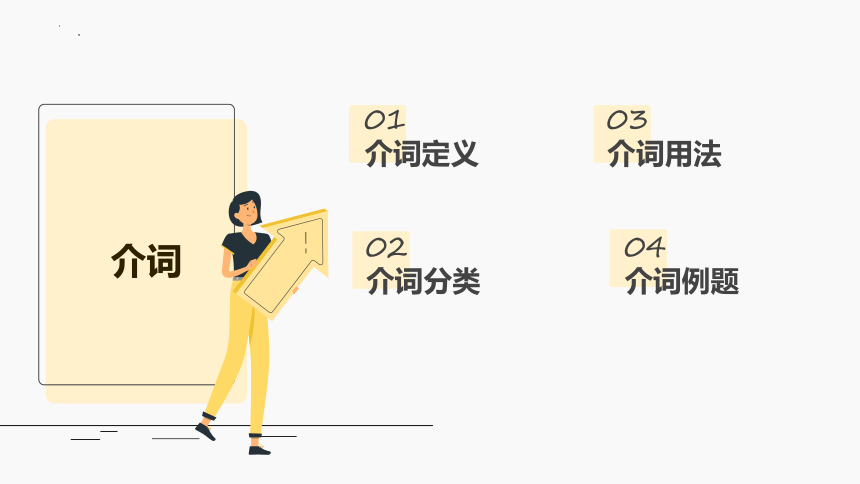
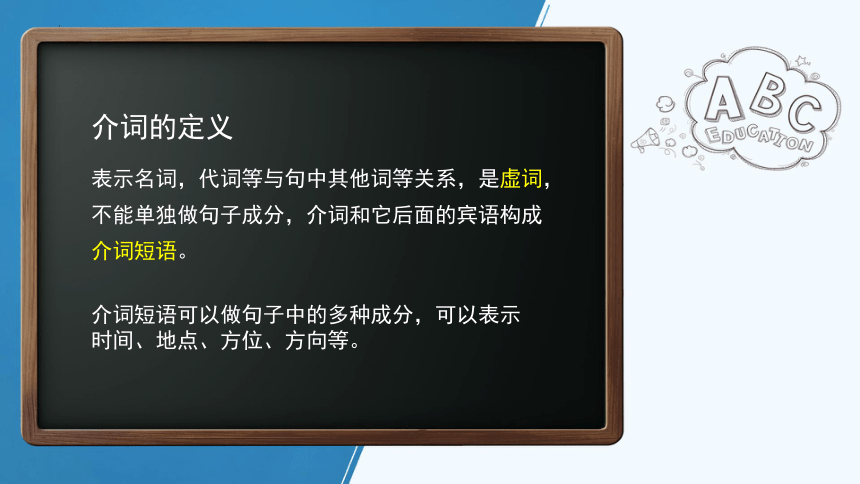
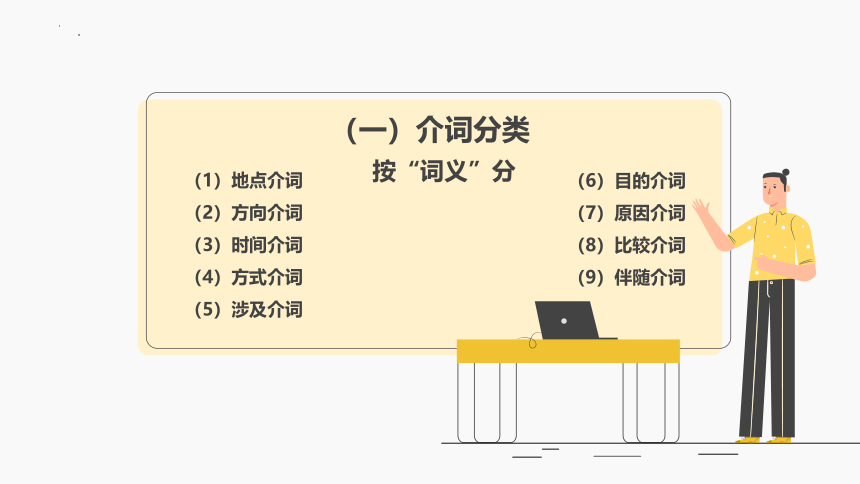
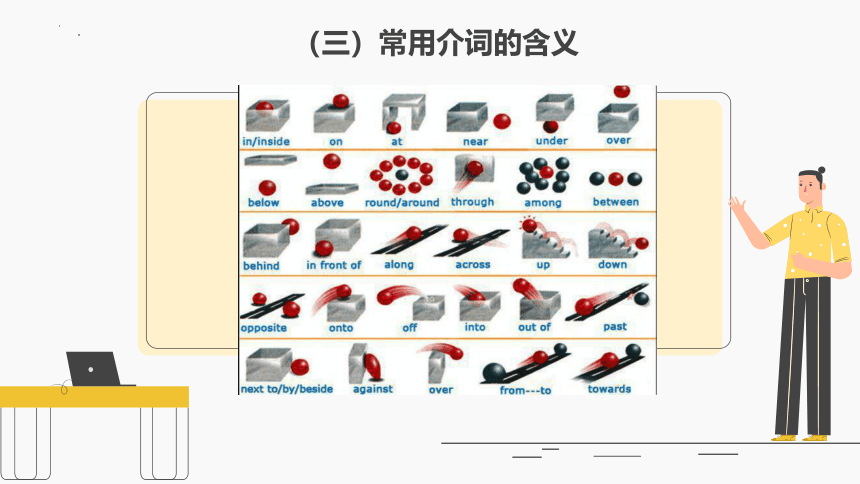

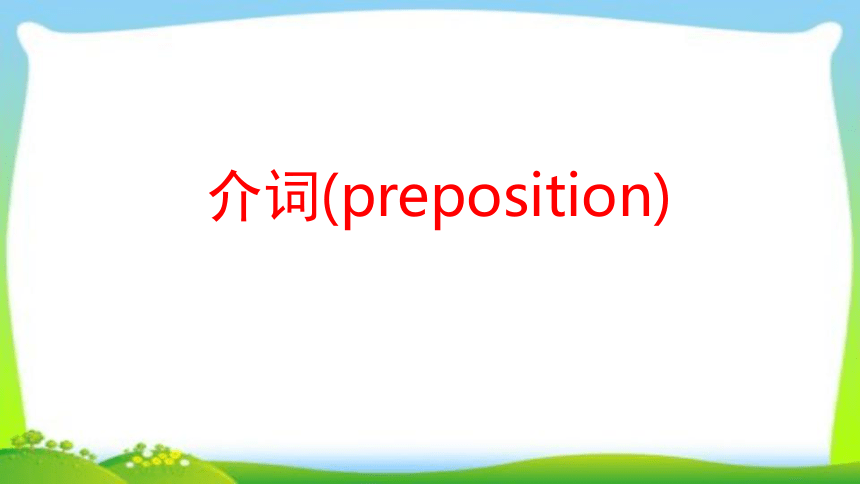
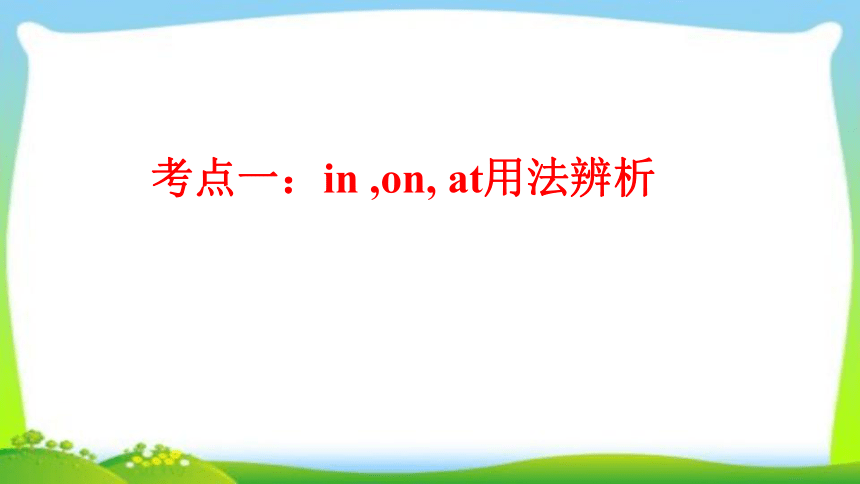
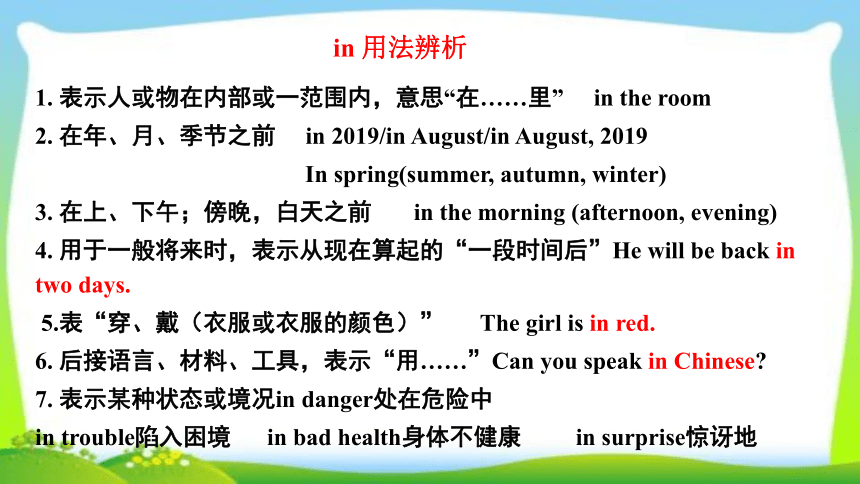

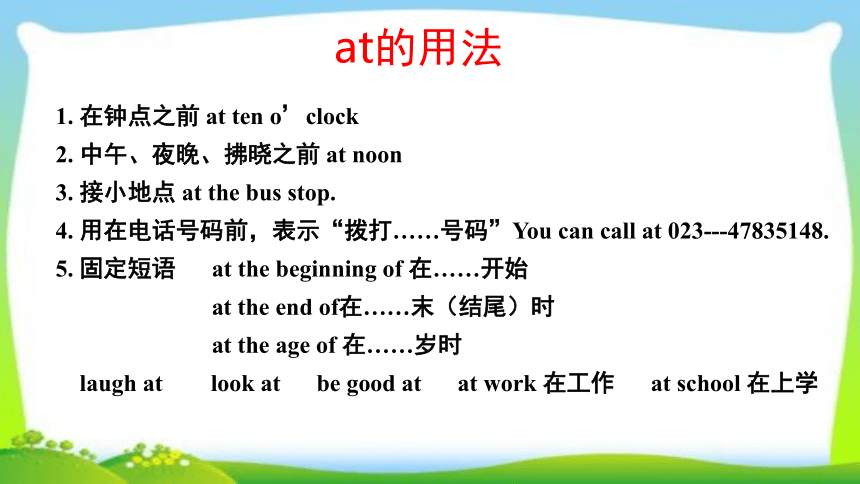
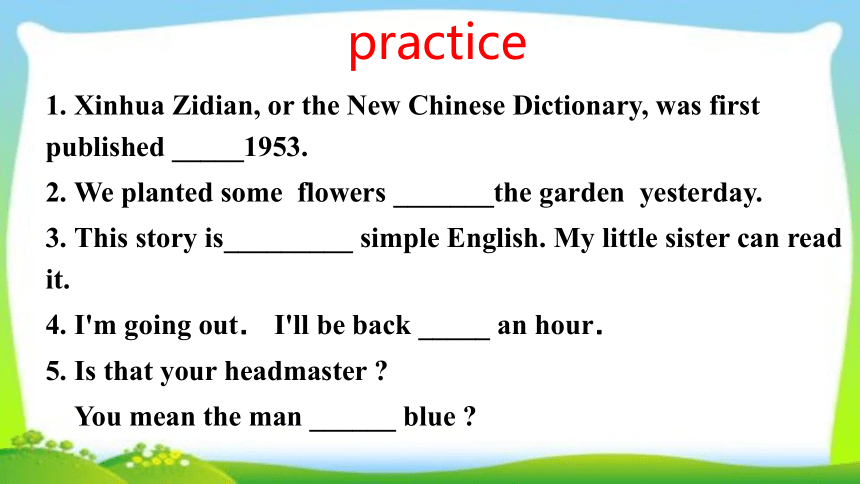
文档简介
(共104张PPT)
介词
01
介词定义
02
介词分类
03
介词用法
介词
04
介词例题
表示名词,代词等与句中其他词等关系,是虚词,不能单独做句子成分,介词和它后面的宾语构成介词短语。
介词短语可以做句子中的多种成分,可以表示
时间、地点、方位、方向等。
介词的定义
(1)地点介词
(2)方向介词
(3)时间介词
(4)方式介词
(5)涉及介词
(一)介词分类
按“词义”分
(6)目的介词
(7)原因介词
(8)比较介词
(9)伴随介词
(三)常用介词的含义
介词(preposition)
考点一:in ,on, at用法辨析
1. 表示人或物在内部或一范围内,意思“在……里” in the room
2. 在年、月、季节之前 in 2019/in August/in August, 2019
In spring(summer, autumn, winter)
3. 在上、下午;傍晚,白天之前 in the morning (afternoon, evening)
4. 用于一般将来时,表示从现在算起的“一段时间后”He will be back in two days.
5.表“穿、戴(衣服或衣服的颜色)” The girl is in red.
6. 后接语言、材料、工具,表示“用……”Can you speak in Chinese
7. 表示某种状态或境况in danger处在危险中
in trouble陷入困境 in bad health身体不健康 in surprise惊讶地
in 用法辨析
1. 表示“在……上面”,指物体表面相接触。 on the desk.
2. 在星期、节日、具体日子之前 on Monday/ on National Day /on August29,2019/
on Thursday morning/ on the afternoon of August 29/ on a cold night.
3. “通过、以” on the radio(TV)通过收音机(电视)on the phone 通过电话
on the computer 通过电脑
4. “关于” The scientist will give a talk on 5G mobile phone next Monday afternoon.
5. “从事……中” on business 出差 on duty值日、值班 on holiday度假 on show在展出
6. 表示与某一地区毗邻的关系,即接壤,如中国与越南、老挝,蒙古、俄罗斯等国接壤 Thailand is on the southeast of China.
on 用法辨析
at的用法
1. 在钟点之前 at ten o’clock
2. 中午、夜晚、拂晓之前 at noon
3. 接小地点 at the bus stop.
4. 用在电话号码前,表示“拨打……号码”You can call at 023---47835148.
5. 固定短语 at the beginning of 在……开始
at the end of在……末(结尾)时
at the age of 在……岁时
laugh at look at be good at at work 在工作 at school 在上学
practice
1. Xinhua Zidian, or the New Chinese Dictionary, was first published _____1953.
2. We planted some flowers _______the garden yesterday.
3. This story is_________ simple English. My little sister can read it.
4. I'm going out. I'll be back _____ an hour.
5. Is that your headmaster
You mean the man ______ blue
6. Beijing Expo 2019 opened to the public ________ 29th April. It will last over five months.
7. The accident took place________ a cold November evening.
8. Yesterday our headmaster made a speech ______ environmental protection,and we learned something about recycling of waste.
9. Most of the villagers took part in the Dragon Boat races______9:00 a. m. _____ the morning of June 7.
10. ---Is Mr Green at school?---Sorry,I don't know. But you can call him_____340﹣5261.
考点二:by ,as, with用法辨析
by用法解析
1. 表示位置,意思是:“在……旁边,靠近……” by the lake.
2. 表示出行的方式,意思是:“乘” by bus
3. 表示方式或手段, 意思是“用;借;通过”等
You can improve your English by reading.
4. 表示时间,意思是:“到…为止,不迟于”
You must come back by 9:00 p.m.
5. 用于被动语态表示动作的发出者,意思是:“被”。
The room is cleaned by the boy.
6. 部分by固定短语 one by one 一个接一个 day by day一天又一天
year by year 一年又一年 by the way顺便问一下
by oneself by hand用手
as用法解析
1. 表身份,意思“作为……” As a student,……
2. 表示形似,意思是“好像……;像……”
The little girl speaks as an adult.
3. 构成固定短语 works as以…为职业
be famous(known) as 以…著称
act as担当…角色
look on (regard)…as…把…看作…
choose...as 选……作为
use..as..用……作为
with用法解析
1. “和(与)……在一起”
The old woman lives with her son.
2. “具有、持有、随身带着”
He bought a house with a garden。
3.“在……之下”,表示缘由
“在帮助下”,英语用with the help of 或with one’s help.
practice
1.On sunny days, my grandma often reads a novel ____ the window.
2.John often takes a walk _______ his grandpa after dinner.
3. My English teacher always comes into the classroom ____a smile.
4. __________ the help of modern technology, scientists got a photo of a black hole.
5. ______ a student, we should study hard.
其他介词
after 用在时刻之后after 2:00
till(until) ①用于肯定句,意思“到……”
②用于否定句,意思为“直到……才”
over “在……之上”,表示在…正上方,强调垂直关系
above “在……上方”,指高于物体上方的任意一点,不接触, 不一定垂直
under “在……下方”,over反义词。
below “在……下方”,above反义词。
in front of 表示在物或人的前面,常位于静止状态的动词前
in the front of 表示在某一空间范围内的前部
behind 表示在物或人的后面,常位于静止状态的动词前,反义词为in front of
between “在……之间”,强调在两者之间,可与and搭配
among “在……之间”,强调三者或三者以上的人或事物之间
across “横穿;对过”,表示从物体的表面通过、穿过或沿某一条线的方向而进行的动作
through “穿过、透过”,表示从某一空间通过
along “沿着;顺着”,表示沿某一路线(街道,河流)等
against 表示位置,意思是“靠着”
表示“反对”“对着”“违反”“不利于”等
practice
1.The high-speed train ______ Qingdao and Beijing travels faster now. The train ride takes only about three hours.
2.Look! A boy is drawing _____ the bridge which is ____ the river.
3. The bright sunlight comes into the room _____ the window.
4. Excuse me. Where is the nearest bookstore?
Go ______Center Street and you' ll find it.
用 in on next to over above under 表示右边彩球和立方体的位置关系
1.The green ball is ____the cube.
2.The blue ball is _______the cube.
3.The red ball is ______the cube.
4.The purple ball is ____the cube.
5.The pink ball is _____the cube.
6.The orange ball is _____the cube
in
next to
on
over
above
方位介词
under
1.表示时间和日期的介词
(1)at, on, in
e.g. We will have a meeting at 8 o’clock in the morning on Sunday.
e.g. He came on the morning of a sunny day in winter in 2019.
我们将在星期天早上八点开会。
他在2019年冬季一个阳光明媚的早上到达了。
(2) for, during, through
e.g. The new student looked at the teacher for a few seconds.
这个新来的学生看了老师几秒钟。
e.g. I went to Shanghai during the summer holiday.
暑假期间我去了上海。
e.g. They worked hard through the winter.
整个冬天他们都在努力工作。
总结 2:for a few seconds
for + 一段时间, 表示某事持续多久。
during the summer holiday
during 表示 “在......期间”。
through the winter
through 表示 “一直......, 自始至终 ” 。
(3)from, since
e.g. I was waiting there from morning till noon.
我在那里从早上等到中午。
e.g. Great changes have taken place in our school since 2010.
自从2010年以来,我们学校发生了巨大的变化。
总结 3:from 表示时间的起点,多用于from... to/until...。
since 表示 “自从......以来”,与完成时连用。
区分 since 和 for: since + 时间点
for + 时间段
(4)before, by, till, until
e.g. Please come back before 8 o’clock.
e.g. You must hand in your homework by 10 o’clock tomorrow.
e.g. I will wait till/until tomorrow.
I will not leave until tomorrow.
总结 4:before 指 “在......之前”, 与 after 相对。
by 指 “到......时为止,在......之前”。
till/until 指 “直到......时”,肯定句中用延续性动词,
否定句中用瞬间动词。
2.表示方位的介词
(1)on, over, above
e.g. There is an apple on the table.
e.g. There is a bridge over the river.
e.g. There is a plane flying above the city.
总结 1:三个介词均意为 “在......上面”,区别是什么呢?
使用 on 时,表示两个物体相接触,一个在另一个之上。
使用 over 时,表示一个物体在另一个物体的垂直正上方。
使用 above 时,表示一个物体在另一个物体的上方,不接
触,也不一定垂直。
拓展:
e.g. She has only the director over her. 处于......的职位之上
e.g. Snow is falling all over the country. 遍及、遍布
e.g. Tonight, temperatures should be above zero. ......度以上
e.g. The salaries we offer are well above average. 高于(平均水平)
2.表示方位的介词
(2)beneath, under, below
e.g. Mary enjoyed feeling the warm sand beneath her feet.
e.g. Wendy had hidden the box under her bed.
e.g. I could hear voices in the courtyard below my window.
总结 2:三个介词均意为 “在......下面”,区别是什么呢?
使用 beneath 时,表示两个物体相接触,一个在另个的下面。
使用 under 时,表示一个物体在另一个物体的垂直正下方。
使用 below 时,表示一个物体在另一个物体的下方,不接
触,也不一定垂直。
2.表示方位的介词
(3)across, through
e.g. This is the only bridge across the river.
e.g. The train went through a tunnel.
总结 3:两个介词都有“穿过”的意思,有什么区别呢?
across 意为 “横穿,穿过”,从一边到另一边; 横过。
through 指从物体的内部 “穿过”,从一端至另一端;
穿过; 贯穿; 经过。
拓展:
e.g. There is a bank across the street. 在......的对面
e.g. They have gone through many difficulties together. 经历
2.表示方位的介词
(4)in, on, to
e.g. Tianjin is in the north of China.
e.g. Mongolia is on the north of China.
e.g. Japan is to the east of China.
总结 4:描述两者间的位置关系。
in 表示 “一方在另一方的内区域 ”。
on 表示 “两者接壤或相邻”。
to 表示 “两者在不属于同一范围,也不接壤的情况下的
相对位置。
3.表示计量的介词
(1)at, for, by
e.g. We have all pants in all color at 20 dollars.
e.g. The house was sold at a rather low price.
e.g. He sold his car for 500 dollars.
e.g. They are paid by the day.
e.g. The apples are sold by weight.
总结 1:at 表示 “以......的价格或具体价格”。
for 表示 “换取......” 的意思。
by + the + 具体单位。
by + 具体度量名词前零冠词。
4.表示行为的工具、手段或者方式的介词
(1)by, with, in, through
e.g. I went there by car.
e.g. We speak with our mouths and write with a pen.
e.g. Please speak in English and write in ink.
e.g. You can only get there in this way.
e.g. You can only achieve success through hard work.
总结 1:by 表示方式,多用于交通。
with 表示用某种具体工具或身体部位。
in 表示用某种材料或语言,或 in...way 表示 “用......方式”。
through 表示 “以(方法、手段),经由,通过”,
多接抽象名词。
5.表示原因的介词
(1)for, at, from, of, with, by
e.g. They are praised for the way they bring up their children.
e.g. He was surprised at the news.
e.g. The young man died from an accident.
e.g. The man died of hunger.
e.g. She took your umbrella by mistake.
e.g. She blushed with embarrassment.
总结 1:
for 表示原因,常与sorry, famous, punish, praise, thank, blame等连用。
at 指情感变化的原因,意为“因听到或看到......而......”。
from 指 “外在的原因”,如受伤、车祸、劳累等。
of 指 “内在的原因”,如疾病、饥饿、年老等。
with 指生理上或情感上的原因。
by 表示外部的原因,例如 by mistake, by violence
6.其他介词
(2)against
e.g. He is standing against the wall.
表示 “与......方向相反”;逆着;顶着;靠着。
e.g. What he did was against the law.
表示 “违反,违背”。
e.g. It was a real race against time to get the project done.
表示 “以......为竞争对手”。
e.g.I’m sorry, but I’m really against your proposal.
表示 “不同意,反对”。
6.其他介词
(3)beyond
e.g. The house is beyond the bridge. 表示“在...... 另一边”
e.g. Don’t stay here beyond midnight. 表示 “迟于;晚于”
e.g. The switch on the wall was beyond the children’s reach.
e.g. Math is beyond me. I can never get high grades.
表示 “超出......(范围), 非......所能及, 对......来说太难”
5.其他介词
(4)as
e.g. They were all dressed as clowns. 表示“像,如同”
e.g. He was treated as a hero. 表示 “作为,当做”
treat/regard/see/describe/announce/think of ... as ...
1. —When were you born
—I was born _____ the morning of June 1st, 1998.
A. in B. on C. at D. from
2. He was a good student and scored _____ average in most
subjects.
A. below B. of C. on D. above
√
√
Step 4: Language practice
3. It was a real race _____ time to get the project done.
Luckily, we made it.
A. over B. by C. for D. against
4. Some abstract modern paintings were _____ my understanding; I simply couldn’t figure out what the painters really wanted to tell us.
A. within B. behind C. around D. beyond
√
√
5. The Great Wall travels _____ deep valleys, _____ deserts
and _____ mountains.
A. over, across, through B. through, over, across
C. across, through, over D. through, across, over
6. _____ basketball, what other sports do you like
A. Except B. Expect C. Besides D. Beside
√
√
Where is the pen
It’s the box.
on
It’s_____the box.
in
Where’s the pen
It’s _______ the box.
under
It’s ______ the box.
behind
The yellow box is
near the orange box.
under
behind
in
on
near
一.地点介词
1.at the village , at home, at the corner of the street..
______________________
2.in Shanghai , in the country, in Asia, in the world,
in space…
_______________________
表示小地方用at
表示大地方用in
表示地点的介词
在外面的拐角处用at
在里面的拐角处用in
in the corner
at the corner
表示地点的介词
介词in on to与方位词的关系
方位词:south north west east southeast southwest northeast northwest
例:1.China lies in the east of Asia.
2.Japan lies to the east of China. 3.Mongolia lies on the north of China.
through
across
Prepositions of movement 运动介词
横穿
从内部穿过
用across和through填空
1.The Great Wall is the northwest of China.
2.Look!The man is swimming the lake.
3.The sunlight comes the glass.
4.We must go the road very carefully.
5.The tiger is jumping the burning ring.
across
across
through
across
through
表示时间的介词
after+时间点 在……之后
1.We will meet after six.
六点之后我们会见面。
2.We’ll hold a party after dinner.
晚饭过后我们会举办一个聚会。
表示时间的介词
before+时间点 在……之前
1.You should finish your homework before 9’o clock.
你应该在9点前把作业完成。
2.We have met before coming here.
我们在来这儿之前就已经见过面了。
表示时间的介词
in+一段时间 在……时间之后
1.My father will come back in three days.
我爸爸三天后将会回来。
2.We’ll meet in a week.
一周之后我们将会见面。
表示方式、工具的介词
by+水陆空状态词也表示交通方式,如:
by road
by land
by sea
by water
by air
公路运输;乘汽车
陆地运输
海路运输;乘船
水路运输;乘船
航空运输;搭飞机
表示方式、工具的介词
by+通讯方式 表示“用…作为联系方式”
by letter
by e-mail
by phone
书信联系;以书信的方式
邮件联系
打电话;电话联系
表示方式、工具的介词
in+语言 表示“用…语言”
例:in Chinese 用中文
in French 用法语
How do you spell your name in English?
How to say “hello” in German?
in+颜色
例:The man in red clothes is Father Christmas.
in固定搭配
in time 及时
on time 准时
in the sky 在空中
in a low voice 低声说
in life 在生活中
表示方式、工具的介词
with+具体的工具或五官 表示“用……”
例:eat with a spoon
write with a pencil
用勺子吃
用铅笔写
时间介词
阅读下面短语和句子,思考标红介词的用法。
in 2011
in January
in summer
in the 21st century
in the morning
in 10 years
on Monday
on May Day
on March 12th
on Sunday afternoon
on a cold morning
at seven o’clock(7:00)
at half past five(5:30)
用between和among填空
1.The girl is _______ the two boys.
2.The red apple is ______green apples.
用across和through填空
1.Go ______the bridge, and you will find the park.
2. You’ll be closer to your destination if you go _____ the city.
用except和besides填空
1.They all passed the exam _____Tom.
2.They all passed the exam _____Tom.
Tom Anna Lily
1. 50 80 75
2. 66 73 82
between
among
across
through
except
besides
常见介词 议展:区分以下几组单词,讨论它们的用法。
用between和among填空
1.The girl is between the two boys.
2.The red apple is among green apples.
用across和through填空
1.Go across the bridge, and you will find the park.
2. You’ll be closer to your destination if you go through the city.
用except和besides填空
1.They all passed the exam except Tom.
2.They all passed the exam besides Tom.
between表示在两者之间
among表示在三者或三者以上的人或物之间
across强调从表面穿过
through强调从一定的空间内穿过
except表示“除…之外”,指从整体中排除,except所带的人或物
Besides表示“除…之外(还有)”,它的意思是在原来的基础上加上besides除外的人或物
检:(3mins)
1.I will live for Beijing for Shenzhen ____9 p.m. ____ October 1st.
2.You can enter the city ______ the forest.
3.My uncle’s reviews on the four great classical Chinese novels may be published _____ the summer of 2021.
4.Han clothing is becoming more popular _____ young people.
5.Don’t use your mobile phone when you go ______ the road. It’s dangerous.
6.We must wait ____the owner of the wallet comes.
7.He gave me a box of chocolates _____ a bottle of milk.
at
through
on
across
among
in
until
besides
____ Friday evening ______ the 1980s
____ the age of _____ midnight
____ the Tang Dynasty _____ last Sunday
Exercises
1.Japan lies ____ the east of China.
2.There is a bridge _____ the river.
on
in
at
at
in
/
to
over
3.________ the windows of her house is a
supermarket.
4. _______ the chair there is a cat sleeping.
5.Her son was too fat to go________ the door.
6.He saw me and came to me _______the road.
Exercises
Below
Under
through
across
表示时间
01
1、表示在某时间.常用前置词at,on,in等。
at
on
in
表示在某一段时刻
at dawn/daybreak, at six , at midnight
表示在……岁时
at sixteen/at the age of sixteen
表示在星期几/某日
on Monday :在星期一
on January fifth:在1月5日
on New Year's Day:在新年那天
表向前移动
on the left/right 向左/右移动
表示一天中的早中晚,月份,季节或年份
in the morning 在早晨
in January/February 在一月,二月
in Spring 在春天
可加衣物,表穿……,戴……
in red 穿红色的衣服
表示“用……”
in English 用英语说
“在……方面”
do well in…… 在……方面做得好
2. 表示 期间 常用前置词during,for,over,within,throughout,from和to等
01
during
for
用于已知的一段时间包括大家熟知的节日或者某种已确切限定的时期或阶段之前
during the Middle Ages: 在中世纪
during 1942 :在1942年中
during the summer(of that year):在(那一年的)夏季
during his childhood :在他童年时期
用来表示一段时间
for six years :六年之久
for two months :有两个月
for ever :永远
表示其他时间概念的前置词有before,after,since,until,till,between,up to等
表示时间
表示方位
02
at
in
on
to
(1)表示在小地方; (2)表示“在...附近,旁边”
(1)表示 在大地方; (2)表示“在...范围之内”
表示毗邻,接壤,“在...上面”
表示在……范围外,不强调是否接壤;或“到……”
表示方位
02
above
over
on
指在……上方,不强调是否垂直,与 below相对
The bird is flying above my head.
指垂直的上方,与under相对,但over与物体有一定的空间,不直接接触
There is a bridge over the river.
表示某物体上面并与之接触
He put his watch on the desk.
表示方位
02
below
under
表示在…正下方
表示在…下,不一定在正下方
There is a cat under the table.
Please write your name below the line.
in front of
in the front of
在…前面,指甲物在乙物之前,两者互不包括;其反义词是behind(在…的后面)
There are some flowers in front of the house.
“在…的前部”,即甲物在乙物的前部.反义词是at the back of…(在…范围内的后部)
There is a blackboard in the front of our classroom.
易混介词辨析
1.时间或地点介词in, on, at
表时间
①in:表示在一段时间里;在将来时句子中表示在一段时间之后;
②on:表示具体的某一天;
③at:表示某个时刻或瞬间。
总结 1:at + 某一时刻
on + 某一天,某一天的上午、下午或晚上
in + 年、季节、月份, 或泛指上午、下午或晚上
易混介词辨析
1.时间或地点介词in, on, at
表地点
①in:表示在某个范围之内;
②on:表示在某个平面上或与一个面相接触;
③at:表示某个具体的场所或地点。
易混介词辨析
2.时间介词after与in“在…之后”
①after+(具体时刻/从句):表示“在…时刻之后”常用于一般时态
②“in+(一段时间)”:表示“在(多久)之后”,常用于将来时态。
易混介词辨析
He said that he would be here after 6:00.
My father is coming back from England in about a month.
易混介词辨析
3.时间介词since与for
①since+(具体时间/that 从句):“自…起一直到现在”
②for+(一段时间):“总共有…之久”
易混介词辨析
3.时间介词since与for
Uncle li has worked in this factory since 1970.
Uncle Li has worked in this factory for over 30 years.
易混介词辨析
4.方式介词by, in与with“工具、手段”
①by:乘坐某交通工具;以…方式;在被动句中可以表示动作的执行者
②in:使用某语言/文字
③with:使用某工具、手段
易混介词辨析
4.方式介词by, in与with“工具、手段”
We see with our eyes and walk with our feet.
Please write that article in English.
Let’s go to the zoo by taxi.
易混介词辨析
5.throught,across与over
①through:“穿过…(门洞/人群/树林)”
②across和over:指“跨越…(街道/河流)”,可互换;表示“翻过…”只用over
易混介词辨析
5.throught,across与over
There is a bridge across/over the river.
They climbed over the mountain and arrived there ahead of the time.
The visitors went through a big gate into another park.
易混介词辨析
6.as与like“像”
①as:“作为…”,表职业、职务、作用等事实
②like:“像…一样”,表外表,不是事实
易混介词辨析
6.as与like“像”
Let me speak to you as a father.
我以父亲的身份和你讲话。(说话者是听者的父亲)
Let me speak to you like a father.
让我像一位父亲一样和你说话。(说话者不是听者的父亲)
易混介词辨析
7.at the end of, by the end of, to the end, in the end
①at the end of…:既可以表时间也可以表地点,常用过去时;
②by the end of…:表时间,常用完成时;
易混介词辨析
7.at the end of, by the end of, to the end, in the end
③in the end与 at last基本等义,表“终于、最后”,常用过去时;
④to the end…:“到…的终点为止”
易混介词辨析
By the end of last term we had learned 16 units of this book.
At the end of the road you can find a big white house with brown windows.
易混介词辨析
They left for Beijing at the end of last week.
In the end he succeeded in the final exams.
We should go on with work to the end.
易混介词辨析
8.for a moment, for the moment, in a moment, at the moment
①for a moment:“一会儿、片刻”,常与持续性动词连用
② for the moment:“暂时、目前”,常用现在时;
易混介词辨析
8.for a moment, for the moment, in a moment, at the moment
③in a moment:“一会儿、立刻、马上”,用将来时;
④at the moment:“此刻、眼下”,用现在进行时。
易混介词辨析
Please wait for a moment.
Let’s leave things as they are for the moment.
I’ll come back in a moment.
I am very busy at the moment.
易混介词辨析
9.in front of 与 in the front of
①in front of:“在…的前面”
②in the front of:“在…的前部”
易混介词辨析
A car was parking in front of the hall.
In the front of the hall stood a big desk.
易混介词辨析
10. expect与besides
①expect:“除了”,表不包含
②besides:“除了”,表包含
易混介词辨析
Everyone went to the Palace Museum except Tom.
除了Tom,大家都去了故宫博物院。
Besides Chinese he also studied many other subjects.
除了汉语之外,他还学其他许多功课。
介词
01
介词定义
02
介词分类
03
介词用法
介词
04
介词例题
表示名词,代词等与句中其他词等关系,是虚词,不能单独做句子成分,介词和它后面的宾语构成介词短语。
介词短语可以做句子中的多种成分,可以表示
时间、地点、方位、方向等。
介词的定义
(1)地点介词
(2)方向介词
(3)时间介词
(4)方式介词
(5)涉及介词
(一)介词分类
按“词义”分
(6)目的介词
(7)原因介词
(8)比较介词
(9)伴随介词
(三)常用介词的含义
介词(preposition)
考点一:in ,on, at用法辨析
1. 表示人或物在内部或一范围内,意思“在……里” in the room
2. 在年、月、季节之前 in 2019/in August/in August, 2019
In spring(summer, autumn, winter)
3. 在上、下午;傍晚,白天之前 in the morning (afternoon, evening)
4. 用于一般将来时,表示从现在算起的“一段时间后”He will be back in two days.
5.表“穿、戴(衣服或衣服的颜色)” The girl is in red.
6. 后接语言、材料、工具,表示“用……”Can you speak in Chinese
7. 表示某种状态或境况in danger处在危险中
in trouble陷入困境 in bad health身体不健康 in surprise惊讶地
in 用法辨析
1. 表示“在……上面”,指物体表面相接触。 on the desk.
2. 在星期、节日、具体日子之前 on Monday/ on National Day /on August29,2019/
on Thursday morning/ on the afternoon of August 29/ on a cold night.
3. “通过、以” on the radio(TV)通过收音机(电视)on the phone 通过电话
on the computer 通过电脑
4. “关于” The scientist will give a talk on 5G mobile phone next Monday afternoon.
5. “从事……中” on business 出差 on duty值日、值班 on holiday度假 on show在展出
6. 表示与某一地区毗邻的关系,即接壤,如中国与越南、老挝,蒙古、俄罗斯等国接壤 Thailand is on the southeast of China.
on 用法辨析
at的用法
1. 在钟点之前 at ten o’clock
2. 中午、夜晚、拂晓之前 at noon
3. 接小地点 at the bus stop.
4. 用在电话号码前,表示“拨打……号码”You can call at 023---47835148.
5. 固定短语 at the beginning of 在……开始
at the end of在……末(结尾)时
at the age of 在……岁时
laugh at look at be good at at work 在工作 at school 在上学
practice
1. Xinhua Zidian, or the New Chinese Dictionary, was first published _____1953.
2. We planted some flowers _______the garden yesterday.
3. This story is_________ simple English. My little sister can read it.
4. I'm going out. I'll be back _____ an hour.
5. Is that your headmaster
You mean the man ______ blue
6. Beijing Expo 2019 opened to the public ________ 29th April. It will last over five months.
7. The accident took place________ a cold November evening.
8. Yesterday our headmaster made a speech ______ environmental protection,and we learned something about recycling of waste.
9. Most of the villagers took part in the Dragon Boat races______9:00 a. m. _____ the morning of June 7.
10. ---Is Mr Green at school?---Sorry,I don't know. But you can call him_____340﹣5261.
考点二:by ,as, with用法辨析
by用法解析
1. 表示位置,意思是:“在……旁边,靠近……” by the lake.
2. 表示出行的方式,意思是:“乘” by bus
3. 表示方式或手段, 意思是“用;借;通过”等
You can improve your English by reading.
4. 表示时间,意思是:“到…为止,不迟于”
You must come back by 9:00 p.m.
5. 用于被动语态表示动作的发出者,意思是:“被”。
The room is cleaned by the boy.
6. 部分by固定短语 one by one 一个接一个 day by day一天又一天
year by year 一年又一年 by the way顺便问一下
by oneself by hand用手
as用法解析
1. 表身份,意思“作为……” As a student,……
2. 表示形似,意思是“好像……;像……”
The little girl speaks as an adult.
3. 构成固定短语 works as以…为职业
be famous(known) as 以…著称
act as担当…角色
look on (regard)…as…把…看作…
choose...as 选……作为
use..as..用……作为
with用法解析
1. “和(与)……在一起”
The old woman lives with her son.
2. “具有、持有、随身带着”
He bought a house with a garden。
3.“在……之下”,表示缘由
“在帮助下”,英语用with the help of 或with one’s help.
practice
1.On sunny days, my grandma often reads a novel ____ the window.
2.John often takes a walk _______ his grandpa after dinner.
3. My English teacher always comes into the classroom ____a smile.
4. __________ the help of modern technology, scientists got a photo of a black hole.
5. ______ a student, we should study hard.
其他介词
after 用在时刻之后after 2:00
till(until) ①用于肯定句,意思“到……”
②用于否定句,意思为“直到……才”
over “在……之上”,表示在…正上方,强调垂直关系
above “在……上方”,指高于物体上方的任意一点,不接触, 不一定垂直
under “在……下方”,over反义词。
below “在……下方”,above反义词。
in front of 表示在物或人的前面,常位于静止状态的动词前
in the front of 表示在某一空间范围内的前部
behind 表示在物或人的后面,常位于静止状态的动词前,反义词为in front of
between “在……之间”,强调在两者之间,可与and搭配
among “在……之间”,强调三者或三者以上的人或事物之间
across “横穿;对过”,表示从物体的表面通过、穿过或沿某一条线的方向而进行的动作
through “穿过、透过”,表示从某一空间通过
along “沿着;顺着”,表示沿某一路线(街道,河流)等
against 表示位置,意思是“靠着”
表示“反对”“对着”“违反”“不利于”等
practice
1.The high-speed train ______ Qingdao and Beijing travels faster now. The train ride takes only about three hours.
2.Look! A boy is drawing _____ the bridge which is ____ the river.
3. The bright sunlight comes into the room _____ the window.
4. Excuse me. Where is the nearest bookstore?
Go ______Center Street and you' ll find it.
用 in on next to over above under 表示右边彩球和立方体的位置关系
1.The green ball is ____the cube.
2.The blue ball is _______the cube.
3.The red ball is ______the cube.
4.The purple ball is ____the cube.
5.The pink ball is _____the cube.
6.The orange ball is _____the cube
in
next to
on
over
above
方位介词
under
1.表示时间和日期的介词
(1)at, on, in
e.g. We will have a meeting at 8 o’clock in the morning on Sunday.
e.g. He came on the morning of a sunny day in winter in 2019.
我们将在星期天早上八点开会。
他在2019年冬季一个阳光明媚的早上到达了。
(2) for, during, through
e.g. The new student looked at the teacher for a few seconds.
这个新来的学生看了老师几秒钟。
e.g. I went to Shanghai during the summer holiday.
暑假期间我去了上海。
e.g. They worked hard through the winter.
整个冬天他们都在努力工作。
总结 2:for a few seconds
for + 一段时间, 表示某事持续多久。
during the summer holiday
during 表示 “在......期间”。
through the winter
through 表示 “一直......, 自始至终 ” 。
(3)from, since
e.g. I was waiting there from morning till noon.
我在那里从早上等到中午。
e.g. Great changes have taken place in our school since 2010.
自从2010年以来,我们学校发生了巨大的变化。
总结 3:from 表示时间的起点,多用于from... to/until...。
since 表示 “自从......以来”,与完成时连用。
区分 since 和 for: since + 时间点
for + 时间段
(4)before, by, till, until
e.g. Please come back before 8 o’clock.
e.g. You must hand in your homework by 10 o’clock tomorrow.
e.g. I will wait till/until tomorrow.
I will not leave until tomorrow.
总结 4:before 指 “在......之前”, 与 after 相对。
by 指 “到......时为止,在......之前”。
till/until 指 “直到......时”,肯定句中用延续性动词,
否定句中用瞬间动词。
2.表示方位的介词
(1)on, over, above
e.g. There is an apple on the table.
e.g. There is a bridge over the river.
e.g. There is a plane flying above the city.
总结 1:三个介词均意为 “在......上面”,区别是什么呢?
使用 on 时,表示两个物体相接触,一个在另一个之上。
使用 over 时,表示一个物体在另一个物体的垂直正上方。
使用 above 时,表示一个物体在另一个物体的上方,不接
触,也不一定垂直。
拓展:
e.g. She has only the director over her. 处于......的职位之上
e.g. Snow is falling all over the country. 遍及、遍布
e.g. Tonight, temperatures should be above zero. ......度以上
e.g. The salaries we offer are well above average. 高于(平均水平)
2.表示方位的介词
(2)beneath, under, below
e.g. Mary enjoyed feeling the warm sand beneath her feet.
e.g. Wendy had hidden the box under her bed.
e.g. I could hear voices in the courtyard below my window.
总结 2:三个介词均意为 “在......下面”,区别是什么呢?
使用 beneath 时,表示两个物体相接触,一个在另个的下面。
使用 under 时,表示一个物体在另一个物体的垂直正下方。
使用 below 时,表示一个物体在另一个物体的下方,不接
触,也不一定垂直。
2.表示方位的介词
(3)across, through
e.g. This is the only bridge across the river.
e.g. The train went through a tunnel.
总结 3:两个介词都有“穿过”的意思,有什么区别呢?
across 意为 “横穿,穿过”,从一边到另一边; 横过。
through 指从物体的内部 “穿过”,从一端至另一端;
穿过; 贯穿; 经过。
拓展:
e.g. There is a bank across the street. 在......的对面
e.g. They have gone through many difficulties together. 经历
2.表示方位的介词
(4)in, on, to
e.g. Tianjin is in the north of China.
e.g. Mongolia is on the north of China.
e.g. Japan is to the east of China.
总结 4:描述两者间的位置关系。
in 表示 “一方在另一方的内区域 ”。
on 表示 “两者接壤或相邻”。
to 表示 “两者在不属于同一范围,也不接壤的情况下的
相对位置。
3.表示计量的介词
(1)at, for, by
e.g. We have all pants in all color at 20 dollars.
e.g. The house was sold at a rather low price.
e.g. He sold his car for 500 dollars.
e.g. They are paid by the day.
e.g. The apples are sold by weight.
总结 1:at 表示 “以......的价格或具体价格”。
for 表示 “换取......” 的意思。
by + the + 具体单位。
by + 具体度量名词前零冠词。
4.表示行为的工具、手段或者方式的介词
(1)by, with, in, through
e.g. I went there by car.
e.g. We speak with our mouths and write with a pen.
e.g. Please speak in English and write in ink.
e.g. You can only get there in this way.
e.g. You can only achieve success through hard work.
总结 1:by 表示方式,多用于交通。
with 表示用某种具体工具或身体部位。
in 表示用某种材料或语言,或 in...way 表示 “用......方式”。
through 表示 “以(方法、手段),经由,通过”,
多接抽象名词。
5.表示原因的介词
(1)for, at, from, of, with, by
e.g. They are praised for the way they bring up their children.
e.g. He was surprised at the news.
e.g. The young man died from an accident.
e.g. The man died of hunger.
e.g. She took your umbrella by mistake.
e.g. She blushed with embarrassment.
总结 1:
for 表示原因,常与sorry, famous, punish, praise, thank, blame等连用。
at 指情感变化的原因,意为“因听到或看到......而......”。
from 指 “外在的原因”,如受伤、车祸、劳累等。
of 指 “内在的原因”,如疾病、饥饿、年老等。
with 指生理上或情感上的原因。
by 表示外部的原因,例如 by mistake, by violence
6.其他介词
(2)against
e.g. He is standing against the wall.
表示 “与......方向相反”;逆着;顶着;靠着。
e.g. What he did was against the law.
表示 “违反,违背”。
e.g. It was a real race against time to get the project done.
表示 “以......为竞争对手”。
e.g.I’m sorry, but I’m really against your proposal.
表示 “不同意,反对”。
6.其他介词
(3)beyond
e.g. The house is beyond the bridge. 表示“在...... 另一边”
e.g. Don’t stay here beyond midnight. 表示 “迟于;晚于”
e.g. The switch on the wall was beyond the children’s reach.
e.g. Math is beyond me. I can never get high grades.
表示 “超出......(范围), 非......所能及, 对......来说太难”
5.其他介词
(4)as
e.g. They were all dressed as clowns. 表示“像,如同”
e.g. He was treated as a hero. 表示 “作为,当做”
treat/regard/see/describe/announce/think of ... as ...
1. —When were you born
—I was born _____ the morning of June 1st, 1998.
A. in B. on C. at D. from
2. He was a good student and scored _____ average in most
subjects.
A. below B. of C. on D. above
√
√
Step 4: Language practice
3. It was a real race _____ time to get the project done.
Luckily, we made it.
A. over B. by C. for D. against
4. Some abstract modern paintings were _____ my understanding; I simply couldn’t figure out what the painters really wanted to tell us.
A. within B. behind C. around D. beyond
√
√
5. The Great Wall travels _____ deep valleys, _____ deserts
and _____ mountains.
A. over, across, through B. through, over, across
C. across, through, over D. through, across, over
6. _____ basketball, what other sports do you like
A. Except B. Expect C. Besides D. Beside
√
√
Where is the pen
It’s the box.
on
It’s_____the box.
in
Where’s the pen
It’s _______ the box.
under
It’s ______ the box.
behind
The yellow box is
near the orange box.
under
behind
in
on
near
一.地点介词
1.at the village , at home, at the corner of the street..
______________________
2.in Shanghai , in the country, in Asia, in the world,
in space…
_______________________
表示小地方用at
表示大地方用in
表示地点的介词
在外面的拐角处用at
在里面的拐角处用in
in the corner
at the corner
表示地点的介词
介词in on to与方位词的关系
方位词:south north west east southeast southwest northeast northwest
例:1.China lies in the east of Asia.
2.Japan lies to the east of China. 3.Mongolia lies on the north of China.
through
across
Prepositions of movement 运动介词
横穿
从内部穿过
用across和through填空
1.The Great Wall is the northwest of China.
2.Look!The man is swimming the lake.
3.The sunlight comes the glass.
4.We must go the road very carefully.
5.The tiger is jumping the burning ring.
across
across
through
across
through
表示时间的介词
after+时间点 在……之后
1.We will meet after six.
六点之后我们会见面。
2.We’ll hold a party after dinner.
晚饭过后我们会举办一个聚会。
表示时间的介词
before+时间点 在……之前
1.You should finish your homework before 9’o clock.
你应该在9点前把作业完成。
2.We have met before coming here.
我们在来这儿之前就已经见过面了。
表示时间的介词
in+一段时间 在……时间之后
1.My father will come back in three days.
我爸爸三天后将会回来。
2.We’ll meet in a week.
一周之后我们将会见面。
表示方式、工具的介词
by+水陆空状态词也表示交通方式,如:
by road
by land
by sea
by water
by air
公路运输;乘汽车
陆地运输
海路运输;乘船
水路运输;乘船
航空运输;搭飞机
表示方式、工具的介词
by+通讯方式 表示“用…作为联系方式”
by letter
by e-mail
by phone
书信联系;以书信的方式
邮件联系
打电话;电话联系
表示方式、工具的介词
in+语言 表示“用…语言”
例:in Chinese 用中文
in French 用法语
How do you spell your name in English?
How to say “hello” in German?
in+颜色
例:The man in red clothes is Father Christmas.
in固定搭配
in time 及时
on time 准时
in the sky 在空中
in a low voice 低声说
in life 在生活中
表示方式、工具的介词
with+具体的工具或五官 表示“用……”
例:eat with a spoon
write with a pencil
用勺子吃
用铅笔写
时间介词
阅读下面短语和句子,思考标红介词的用法。
in 2011
in January
in summer
in the 21st century
in the morning
in 10 years
on Monday
on May Day
on March 12th
on Sunday afternoon
on a cold morning
at seven o’clock(7:00)
at half past five(5:30)
用between和among填空
1.The girl is _______ the two boys.
2.The red apple is ______green apples.
用across和through填空
1.Go ______the bridge, and you will find the park.
2. You’ll be closer to your destination if you go _____ the city.
用except和besides填空
1.They all passed the exam _____Tom.
2.They all passed the exam _____Tom.
Tom Anna Lily
1. 50 80 75
2. 66 73 82
between
among
across
through
except
besides
常见介词 议展:区分以下几组单词,讨论它们的用法。
用between和among填空
1.The girl is between the two boys.
2.The red apple is among green apples.
用across和through填空
1.Go across the bridge, and you will find the park.
2. You’ll be closer to your destination if you go through the city.
用except和besides填空
1.They all passed the exam except Tom.
2.They all passed the exam besides Tom.
between表示在两者之间
among表示在三者或三者以上的人或物之间
across强调从表面穿过
through强调从一定的空间内穿过
except表示“除…之外”,指从整体中排除,except所带的人或物
Besides表示“除…之外(还有)”,它的意思是在原来的基础上加上besides除外的人或物
检:(3mins)
1.I will live for Beijing for Shenzhen ____9 p.m. ____ October 1st.
2.You can enter the city ______ the forest.
3.My uncle’s reviews on the four great classical Chinese novels may be published _____ the summer of 2021.
4.Han clothing is becoming more popular _____ young people.
5.Don’t use your mobile phone when you go ______ the road. It’s dangerous.
6.We must wait ____the owner of the wallet comes.
7.He gave me a box of chocolates _____ a bottle of milk.
at
through
on
across
among
in
until
besides
____ Friday evening ______ the 1980s
____ the age of _____ midnight
____ the Tang Dynasty _____ last Sunday
Exercises
1.Japan lies ____ the east of China.
2.There is a bridge _____ the river.
on
in
at
at
in
/
to
over
3.________ the windows of her house is a
supermarket.
4. _______ the chair there is a cat sleeping.
5.Her son was too fat to go________ the door.
6.He saw me and came to me _______the road.
Exercises
Below
Under
through
across
表示时间
01
1、表示在某时间.常用前置词at,on,in等。
at
on
in
表示在某一段时刻
at dawn/daybreak, at six , at midnight
表示在……岁时
at sixteen/at the age of sixteen
表示在星期几/某日
on Monday :在星期一
on January fifth:在1月5日
on New Year's Day:在新年那天
表向前移动
on the left/right 向左/右移动
表示一天中的早中晚,月份,季节或年份
in the morning 在早晨
in January/February 在一月,二月
in Spring 在春天
可加衣物,表穿……,戴……
in red 穿红色的衣服
表示“用……”
in English 用英语说
“在……方面”
do well in…… 在……方面做得好
2. 表示 期间 常用前置词during,for,over,within,throughout,from和to等
01
during
for
用于已知的一段时间包括大家熟知的节日或者某种已确切限定的时期或阶段之前
during the Middle Ages: 在中世纪
during 1942 :在1942年中
during the summer(of that year):在(那一年的)夏季
during his childhood :在他童年时期
用来表示一段时间
for six years :六年之久
for two months :有两个月
for ever :永远
表示其他时间概念的前置词有before,after,since,until,till,between,up to等
表示时间
表示方位
02
at
in
on
to
(1)表示在小地方; (2)表示“在...附近,旁边”
(1)表示 在大地方; (2)表示“在...范围之内”
表示毗邻,接壤,“在...上面”
表示在……范围外,不强调是否接壤;或“到……”
表示方位
02
above
over
on
指在……上方,不强调是否垂直,与 below相对
The bird is flying above my head.
指垂直的上方,与under相对,但over与物体有一定的空间,不直接接触
There is a bridge over the river.
表示某物体上面并与之接触
He put his watch on the desk.
表示方位
02
below
under
表示在…正下方
表示在…下,不一定在正下方
There is a cat under the table.
Please write your name below the line.
in front of
in the front of
在…前面,指甲物在乙物之前,两者互不包括;其反义词是behind(在…的后面)
There are some flowers in front of the house.
“在…的前部”,即甲物在乙物的前部.反义词是at the back of…(在…范围内的后部)
There is a blackboard in the front of our classroom.
易混介词辨析
1.时间或地点介词in, on, at
表时间
①in:表示在一段时间里;在将来时句子中表示在一段时间之后;
②on:表示具体的某一天;
③at:表示某个时刻或瞬间。
总结 1:at + 某一时刻
on + 某一天,某一天的上午、下午或晚上
in + 年、季节、月份, 或泛指上午、下午或晚上
易混介词辨析
1.时间或地点介词in, on, at
表地点
①in:表示在某个范围之内;
②on:表示在某个平面上或与一个面相接触;
③at:表示某个具体的场所或地点。
易混介词辨析
2.时间介词after与in“在…之后”
①after+(具体时刻/从句):表示“在…时刻之后”常用于一般时态
②“in+(一段时间)”:表示“在(多久)之后”,常用于将来时态。
易混介词辨析
He said that he would be here after 6:00.
My father is coming back from England in about a month.
易混介词辨析
3.时间介词since与for
①since+(具体时间/that 从句):“自…起一直到现在”
②for+(一段时间):“总共有…之久”
易混介词辨析
3.时间介词since与for
Uncle li has worked in this factory since 1970.
Uncle Li has worked in this factory for over 30 years.
易混介词辨析
4.方式介词by, in与with“工具、手段”
①by:乘坐某交通工具;以…方式;在被动句中可以表示动作的执行者
②in:使用某语言/文字
③with:使用某工具、手段
易混介词辨析
4.方式介词by, in与with“工具、手段”
We see with our eyes and walk with our feet.
Please write that article in English.
Let’s go to the zoo by taxi.
易混介词辨析
5.throught,across与over
①through:“穿过…(门洞/人群/树林)”
②across和over:指“跨越…(街道/河流)”,可互换;表示“翻过…”只用over
易混介词辨析
5.throught,across与over
There is a bridge across/over the river.
They climbed over the mountain and arrived there ahead of the time.
The visitors went through a big gate into another park.
易混介词辨析
6.as与like“像”
①as:“作为…”,表职业、职务、作用等事实
②like:“像…一样”,表外表,不是事实
易混介词辨析
6.as与like“像”
Let me speak to you as a father.
我以父亲的身份和你讲话。(说话者是听者的父亲)
Let me speak to you like a father.
让我像一位父亲一样和你说话。(说话者不是听者的父亲)
易混介词辨析
7.at the end of, by the end of, to the end, in the end
①at the end of…:既可以表时间也可以表地点,常用过去时;
②by the end of…:表时间,常用完成时;
易混介词辨析
7.at the end of, by the end of, to the end, in the end
③in the end与 at last基本等义,表“终于、最后”,常用过去时;
④to the end…:“到…的终点为止”
易混介词辨析
By the end of last term we had learned 16 units of this book.
At the end of the road you can find a big white house with brown windows.
易混介词辨析
They left for Beijing at the end of last week.
In the end he succeeded in the final exams.
We should go on with work to the end.
易混介词辨析
8.for a moment, for the moment, in a moment, at the moment
①for a moment:“一会儿、片刻”,常与持续性动词连用
② for the moment:“暂时、目前”,常用现在时;
易混介词辨析
8.for a moment, for the moment, in a moment, at the moment
③in a moment:“一会儿、立刻、马上”,用将来时;
④at the moment:“此刻、眼下”,用现在进行时。
易混介词辨析
Please wait for a moment.
Let’s leave things as they are for the moment.
I’ll come back in a moment.
I am very busy at the moment.
易混介词辨析
9.in front of 与 in the front of
①in front of:“在…的前面”
②in the front of:“在…的前部”
易混介词辨析
A car was parking in front of the hall.
In the front of the hall stood a big desk.
易混介词辨析
10. expect与besides
①expect:“除了”,表不包含
②besides:“除了”,表包含
易混介词辨析
Everyone went to the Palace Museum except Tom.
除了Tom,大家都去了故宫博物院。
Besides Chinese he also studied many other subjects.
除了汉语之外,他还学其他许多功课。
